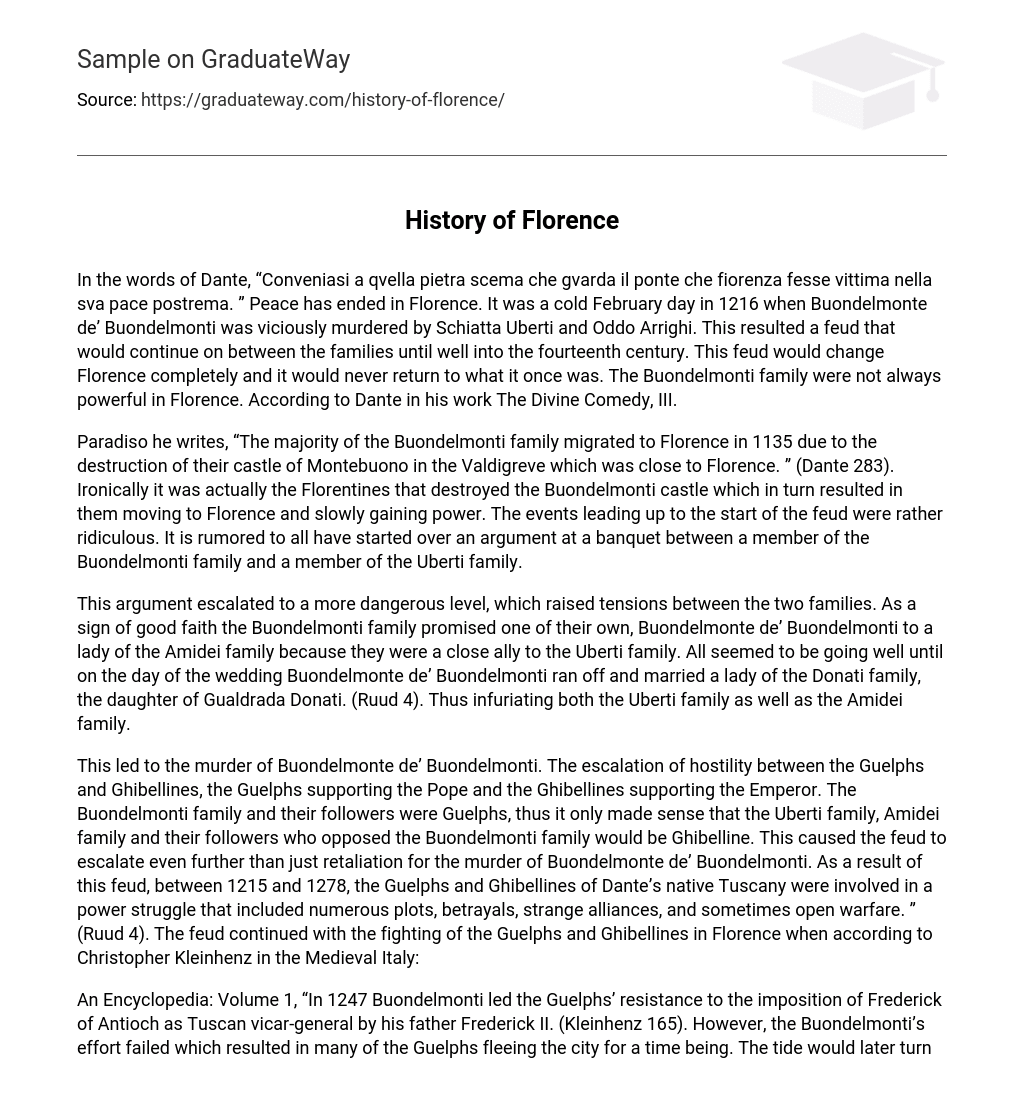In the words of Dante, “Conveniasi a quella pietra scema che guarda il ponte che Fiorenza fece vittima nella sua pace postrema.” Peace has ended in Florence. It was a cold February day in 1216 when Buondelmonte de’ Buondelmonti was viciously murdered by Schiatta Uberti and Oddo Arrighi. This resulted in a feud that would continue between the families until well into the fourteenth century. This feud would completely change Florence, and it would never return to what it once was.
The Buondelmonti family was not always powerful in Florence. According to Dante in his work The Divine Comedy, III, he writes, “The majority of the Buondelmonti family migrated to Florence in 1135 due to the destruction of their castle of Montebuono in the Valdigreve, which was close to Florence” (Dante 283). Ironically, it was actually the Florentines who destroyed the Buondelmonti castle, which resulted in them moving to Florence and slowly gaining power.
The events leading up to the start of the feud were rather ridiculous. It is rumored to have all started over an argument at a banquet between a member of the Buondelmonti family and a member of the Uberti family. This argument escalated to a more dangerous level, which raised tensions between the two families. As a sign of good faith, the Buondelmonti family promised one of their own, Buondelmonte de’ Buondelmonti, to a lady of the Amidei family because they were a close ally to the Uberti family. All seemed to be going well until, on the day of the wedding, Buondelmonte de’ Buondelmonti ran off and married a lady of the Donati family, the daughter of Gualdrada Donati (Ruud 4). This infuriated both the Uberti and Amidei families, leading to the murder of Buondelmonte de’ Buondelmonti.
The escalation of hostility between the Guelphs and Ghibellines, the former supporting the Pope and the latter supporting the Emperor, also contributed to the feud. The Buondelmonti family and their followers were Guelphs, thus it only made sense that the Uberti and Amidei families and their followers, who opposed the Buondelmonti family, would be Ghibellines. This caused the feud to escalate even further than just retaliation for the murder of Buondelmonte de’ Buondelmonti. As a result of this feud, between 1215 and 1278, the Guelphs and Ghibellines of Dante’s native Tuscany were involved in a power struggle that included numerous plots, betrayals, strange alliances, and sometimes open warfare” (Ruud 4).
The feud continued with the fighting of the Guelphs and Ghibellines in Florence when according to Christopher Kleinhenz in Medieval Italy: An Encyclopedia: Volume 1, “In 1247, Buondelmonti led the Guelphs’ resistance to the imposition of Frederick of Antioch as Tuscan vicar-general by his father, Frederick II” (Kleinhenz 165). However, the Buondelmontis’ effort failed, resulting in many of the Guelphs fleeing the city for a time. The tide would later turn in 1266 after the Battle of Benevento. To delve more deeply into the Guelphs and Ghibellines in Florence, Jay Ruud in his novel Critical Companion to Dante states, “Citizens relying on Florence’s commercial interests, like the bankers and the wool merchants, tended to be Guelph, while the ‘old money’ aristocracy were generally Ghibellines” (Ruud 4).
The Guelphs eventually prevailed in Florence after a decisive Guelph victory at the Battle of Benevento over the Ghibelline forces of Manfred in 1266. This victory secured peace in Florence for nearly 30 years, until the Guelph party began to split into two rival factions in the 1290s: the Neri, or Black Guelphs, and the Bianchi, or White Guelphs. Eventually, the White Guelphs would become allied with the Ghibelline party. To have a chance to reestablish themselves, many Buondelmontis established strong binding ties with the Angevin court of Naples.
Although the Buondelmonti family was unable to hold office due to the Ordinances of Justice in 1293, many Buondelmontis managed to serve in office and on many missions. For example, Benghi, who married the daughter of Albetti, count of Certaldo, held important military captaincies and was also the podesta of Prato. However, during the Ciompi rebellion in 1378, he was exiled for being a member of the Guelph ruling oligarchy. It was at this time that many Buondelmontis changed their name to Montebuoni, and the feud between the Buondelmonti family and both the Amidei and Uberti families came to an end.
What started out as a disagreement at a banquet led to a complete change in the dynamics of Florence. If this disagreement had not occurred, Buondelmonte de’ Buondelmonti would never have been promised to marry into the Amidei family. Therefore, Buondelmonte de’ Buondelmonti would never have been murdered, causing the true start of the feud. If this had never occurred, the feud would have never begun. Finally, if the feud had never begun, then there most likely would not have been as severe a split between Guelphs and Ghibellines in Florence. All in all, it was this turn of events that would change Florence forever.





